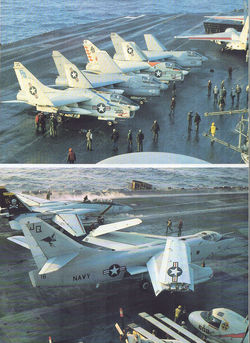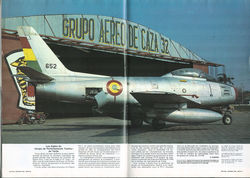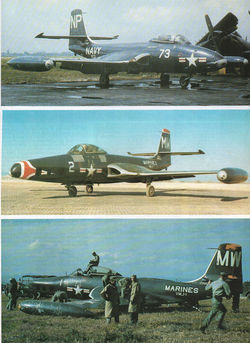AIR FAN 64 McD F2H BANSHEE USN USMC /
USS NIMITZ CVN CVW-8 MED 83 / BOLIVIAN AF F-86F
SINGLE ISSUE OF FRENCH LANGUAGE MAGAZINE OF MILITARY
AVIATION / PHOTO CAPTIONS ARE ALSO PRESENTED IN ENGLISH
***VERY GOOD CONDITION***
FEATURED ARTICLES INCLUDE:
McDONNELL F2H BANSHEE “BANJO” USN VF VC USMC VMF VMJ
KOREAN WAR (INCLUDES 5-VIEW SCALE DRAWINGS & DETAILS)
BOLIVIAN AIR FORCE FAB FUERZA AEREA BOLIVIANA (NORTH
AMERICAN F-86F SABRE, T-28 TROJAN, CESSNA 310, CESSNA 172, NAA AT-6 HARVARD,
PILATUS PC-7 TURBO,
US NAVY NUCLEAR-POWERED AIRCRAFT CARRIER USS NIMITZ
CVN-68 CARRIER WING EIGHT CVW-8 MEDITERRANEAN CRUISE 1983 (GRUMMAN C-1 TRADER
VRC-24, GRUMMAN F-14 TOMCAT VF-84, LOCKHEED S-3 VIKING VS-24, LTV A-7E CORSAIR
II VA-82 VA-86, DOUGLAS EA-3B SKYWARRIOR VAQ-2, GRUMMAN E-2C HAWKEYE VAW-124,
FLIGHT SYSTEMS PRIVATE AIR FORCE (T-33, F-86, FJ-4B, US
NAVY CONVAIR CV 880 UC-880 TANKER, F-100 SUPER SABRE)
--------------------------------------------------------------------------------------
Additional Information from Internet Encyclopedia
The McDonnell F2H Banshee was a single-seat
carrier-based jet fighter aircraft deployed by the United States Navy and
United States Marine Corps from 1948 to 1961. It was one of the primary
American fighters used during the Korean War and was the only jet-powered
fighter ever deployed by the Royal Canadian Navy, serving the RCN from 1955
until 1962. The aircraft's name is derived from the banshee of Celtic
mythology.
The Banshee was a development of the FH Phantom,
although it was being planned before the Phantom went into production.
McDonnell engineers originally intended the aircraft to be a modified Phantom
that shared many parts with the earlier aircraft, but it soon became clear that
the need for heavier armament, greater internal fuel capacity, and other
improvements would make the idea unfeasible.
The new aircraft would use much larger and more
powerful engines, a pair of newly developed Westinghouse J34 turbojets, raising
power from the J30's 1,600 lbf (7 kN) to 3,000 lbf (13 kN) each; since the
larger engines had to fit within the wing roots, this required a larger and
thicker wing with a span of 41 ft 6 in (12.65 m) rather than the Phantom’s span
of 40 ft 0 in (12.19 m). The more powerful engines also used more fuel, so the
fuselage was enlarged and strengthened to increase fuel capacity. Navy leaders
decided to move away from the World War II standard .50-caliber (12.7 mm)
machine gun to 20 mm (0.79 in) cannon; four of the guns were mounted low on the
nose to prevent pilots from being blinded by muzzle flash when firing the guns
at night, a problem that vexed the Phantom with its top-mounted guns. The
Banshee was designed to accommodate an ejection seat, a capability the Phantom
lacked, and it incorporated a large number of improvements to other aircraft
systems. The cockpit was fully pressurized and air-conditioned, and the flaps,
landing gear, folding wings, canopy, and air brakes were electrically operated
rather than pneumatically operated. The front of the canopy was made of
bulletproof glass that was electrically heated to prevent frost.
The aircraft incorporated a novel design feature:
a “kneeling” nose landing gear consisting of a pair of very small wheels
forward of the regular nosewheel. The nosewheel could be retracted so the
aircraft rested on the smaller wheels, allowing it to taxi with its tail high
in the air. This was intended to ease hangaring and enhance safety by directing
the hot jet blast upwards while taxiing. The feature was found to be of little
use operationally, however, and was omitted from later Banshee variants.
The F2H-3 was the last significant alteration. The
fuselage was extended by 8 ft 0 in (2.44 m) to increase internal fuel load to
1,102 gal (4,172 l). The detachable wingtip fuel tanks were reduced in size to
170 gal (644 l) each, but due to the aircraft’s increased internal fuel
capacity, these tanks were seldom used in service. The horizontal stabilizers
were moved from the vertical tail down to the fuselage and incorporated
significant dihedral. The F2H-3 was fitted with a Westinghouse AN/APQ-41 radar
unit, enabling the fighter to be used for all-weather missions, and the cannons
were moved downwards and rearwards away from the nose to accommodate the radar
and increase ammunition capacity from 150 rounds per gun to 220 rounds for each
upper gun and 250 rounds for each lower gun. Another four weapons pylons were
added under the wings for a total of eight, and the bomb load was increased to
3,000 lb (1,361 kg). The F2H-3 also added provisions for aerial refueling
consisting of a bolt-on, readily removable refueling kit that replaced the
upper portside cannon with a refueling probe. These changes resulted in a
longer, larger airplane that looked significantly different from its
predecessors.
Although the Navy accepted the F2H-1, it was the
more capable F2H-2 that was most widely used. With newer Westinghouse J34-WE-34
3,250 lbf (14.5 kN) thrust engines, it had significantly improved performance.
The wing was modified and strengthened to add provisions for 200 gal (760 l)
wingtip fuel tanks; unlike the contemporary USN F9F Panther, the Banshee's
wingtip tanks were detachable. Two armament pylons were added under each stub
and outboard wing, for a total of eight, allowing the aircraft to carry a
maximum stores load of 1,580 lb (454 kg), consisting of four 250 lb (113 kg)
bombs and four 5-in (12.7 cm) unguided rockets.[8] The “kneeling” nose gear was
omitted from the F2H-2 and most other subsequent Banshee variants.
The F2H-2 was the foundation for three minor
variants of the Banshee. The first, the F2H-2B, had strengthened wings and a
strengthened inner pylon under the portside wing to allow the craft to carry a
1,650 lb (748 kg) Mark 7 nuclear bomb or a 3,230 lb (1,465 kg) Mark 8 nuclear
bomb.[9] In order to compensate for the vastly increased load, the F2H-2B was
fitted with stiffer landing gear struts and a pilot-switchable power booster
for the ailerons;[10] the latter was necessary so pilots could control a roll
to the left with a heavy Mark 8 nuclear bomb fitted on the left-hand pylon. One
20 mm cannon was omitted to make room for additional electronics to arm the
nuclear weapon.
The F2H-2N was a night fighter variant outfitted
with a 2 ft 10 in (0.86 m) longer nose that housed a Sperry Corporation
AN/APS-19 radar unit. The cannons were moved rearwards in the nose to make room
for the radar. One F2H-2N, BuNo 123311, was eventually returned to McDonnell to
serve as the prototype for the enlarged and enhanced F2H-3 and F2H-4 series.[9]
A handful of F2H-2Ns retained the "kneeling" nose feature of the
earlier F2H-1.
The F2H-2P was a photo-reconnaissance version with
six cameras housed in a 2 ft 5 in (0.74 m) longer nose; it was the first
jet-powered reconnaissance aircraft used by the USN. Remote controls allowed
the pilot to rotate the cameras in the vertical and horizontal planes, and the
aircraft could be fitted with a pair of underwing pods that each contained 20
flash cartridges for night photography. The camera bay was electrically heated
to prevent frost.[13] The F2H-2P was considered a valuable photo-reconnaissance
asset due to its long maximum range for a jet aircraft, maximum operational
altitude of 48,500 feet, combined with its speed that made it extremely
difficult to intercept by other combat jet aircraft of the early 1950s era.
US Navy and Marine pilots often referred to the
F2H as the "Banjo".[17]
The F2H-2 served during the Korean War with the US
Navy's Task Force 77 and the Marine Corps.
Due to its good performance at high altitude, the
F2H-2 initially proved its worth as an escort fighter for USAF bombers, which
were supporting United Nations Command (UNC) ground forces.
From mid-1950, the F2H-2 had negligible exposure
to hostile aircraft over Korea, due to several factors. During the opening
weeks of the war, the North Korean air force was almost completely annihilated
by UNC fighter units. From that point onwards, North Korea and its allies were
unable to open new airfields near combat zones in South Korea, forcing them to
operate out of air bases in China. As a result of their air superiority
throughout most of 1950, UNC squadrons were restricted to ground attack
missions, especially close air support and interdiction of North Korean army
supply lines.[18] In addition, the Banshee, like most jets of its generation,
had a serious handicap, relative to the latest fighters: naval air services,
including the USN, had resisted faster, swept wing designs – fearing that their
characteristics at low speeds would make them unsafe to operate them from
aircraft carriers. Consequently, the Banshee was almost 100 mph (160 km/h)
slower than the latest fighter designs. The obsolescence of all straight-wing
fighters was reinforced by the introduction, in November 1950 of the
Mikoyan-Gurevich MiG-15 – often covertly operated by elite Soviet units. Most
UNC air combat missions, such as patrols over "MiG Alley", were
undertaken by F-86 Sabres of the USAF Far East Air Force.[18] Consequently, the
F2H-2 operated for virtually the entire war in areas beyond the range of enemy
fighters.[18] During the Korean War, Banshee pilots scored no victories in
air-to-air combat, nor suffered any losses, although three F2H-2s were lost to
anti-aircraft gunfire.
The F2H-2P flew reconnaissance missions during the
Korean War, primarily with the USMC. At the time of the war, accurate
surface-to-air missiles had not yet been developed and the vast majority of
enemy aircraft did not have onboard radar, and AA guns were all but ineffective
at fast, high-altitude targets. Air defense tactics still largely depended on
being able to see the enemy, and US commanders soon discovered that a lone
high-flying F2H-2P was almost impossible for ground forces to spot, much less
shoot down. The aircraft was soon in very high demand for the invaluable
battlefield photography it could provide. F2H-2Ps even received USAF fighter
escorts when operating in areas frequented by enemy fighters. Despite being
deployed constantly throughout the war, only two F2H-2Ps were lost to
radar-directed AA gunfire, with no air-to-air losses.
In 1954, a Banshee flew coast-to-coast, nonstop
without refueling, approximately 1,900 miles (3,100 km) from NAS Los Alamitos,
California to NAS Cecil Field, Florida, in approximately four hours.[14]
During the Korean War, the US was concerned about
a general war in Europe involving the Soviet Union and the total lack of
intelligence on that country, in particular the location of airfields. The US
Navy devised a plan named "Operation Steve Brody", where four F2H-2P
photo reconnaissance Banshees would launch from a carrier cruising on routine
maneuvers off the north-east coast of Greece and fly north photographing the
land mass of Russia bordering the Black Sea. In May 1952, the U.S. Navy
presented the plan to Secretary of Defense Robert Lovett, with the request that
he take it to President Harry Truman. Lovett refused, effectively canceling the
operation.
Later, in 1955, there was another crisis involving
the possible invasion of Taiwan by Communist China. Marine Banshees were chosen
for secret overflights of areas where the Communist Chinese would be preparing
such an invasion. Unlike the purposed photo-flights over the Soviet Union in
1952, these missions were escorted by other Marine Banshee fighters based in
South Korea. Twenty-seven missions took place without incident.
XF2H-1 (XF2D-1)
Prototype aircraft (originally designated XF2D-1),
three built.]
F2H-1
Single-seat fighter version, two 3,000 lbf (1,400
kgf) Westinghouse J34-WE-22 turbojet engines. Initial production version, 56
built.
F2H-2
Improved version with detachable wingtip fuel
tanks, eight underwing weapons pylons for 1,580 lb (454 kg) stores capability,
3,250 lbf (1,475 kgf) Westinghouse J34-WE-34 turbojet engines. Second
production version, 308 built.
F2H-2B
Single-seat fighter-bomber version, strengthened
portside weapons pylon for 3,230 lb (1,465 kg) Mark 8 nuclear bomb, 25 built.
F2H-2N
Single-seat night fighter version with APS-19
radar housed in lengthened nose, 14 built.
F2H-2P
Single-seat photo-reconnaissance version with
lengthened nose housing six cameras, 89 built









